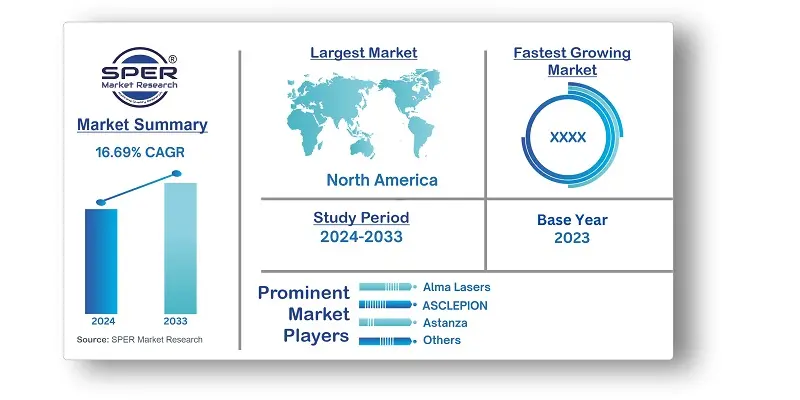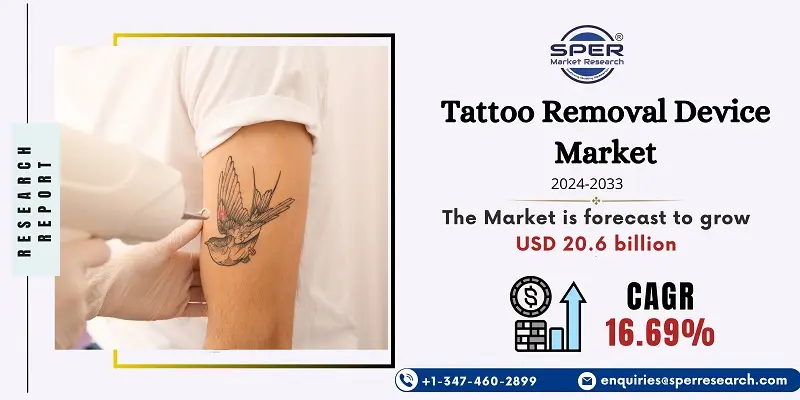
Tattoo Removal Device Market Growth, Size, Trends, Demand, Revenue, Share and Future Outlook
Tattoo Removal Device Market Size- By Product Type, By Technique, By End User- Regional Outlook, Competitive Strategies and Segment Forecast to 2033
| Published: Apr-2024 | Report ID: HLCA2432 | Pages: 1 - 227 | Formats*: |
| Category : Healthcare | |||
- April 2023; Alma Lasers, located in Israel, introduced the Harmony XL Pro+ platform for tattoo removal. This state-of-the-art device used a variety of laser wavelengths and innovative technology to successfully and precisely remove tattoos.
- February 2023; BTL Aesthetics (India), a leading supplier of energy-efficient aesthetic equipment, was bought by Cutting Edge Technologies, Inc. (US). This strategic acquisition expanded Cutura's product offering and market research within the tattoo removal sector.
- January 2023; A significant finance round headed by EW healthcare partners was secured by Syneron Medical Ltd (US). The investment was made with the intention of assisting with research and development projects for creative tattoo removal methods.


| Report Metric | Details |
| Market size available for years | 2020-2033 |
| Base year considered | 2023 |
| Forecast period | 2024-2033 |
| Segments covered | By Product Type, By Technique, By End User |
| Regions covered | North America, Asia-Pacific, Latin America, Middle East & Africa and Europe |
| Companies Covered | Alma Lasers, ASCLEPION, Astanza, Candela Corporation, Cutera, Inc., Cynosure, Inc., Eclipse Skin Technology LTD., Fotona, Lumenis Be Ltd., Lutronic Corporation, Quanta System, and others. |
- Dermatologists and Plastic Surgeons
- Aesthetic Clinics and Medical Spas
- Tattoo Studios
- Beauty and Wellness Centers
- Hospitals and Healthcare Facilities
- Individual Practitioners
- Research Institutions and Academia
- Distributors and Resellers
- Government and Regulatory Bodies
- Consumers
| By Product Type: |
|
| By Technique: |
|
| By End User: |
|
- Global Tattoo Removal Device Market Size (FY’2024-FY’2033)
- Overview of Global Tattoo Removal Device Market
- Segmentation of Global Tattoo Removal Device Market By Product Type (Laser-Based Devices, Radiofrequency Devices, Ultrasound Devices, others)
- Segmentation of Global Tattoo Removal Device Market By Technique (Passive Laser Tattoo Removal Technique, Active Laser Tattoo Removal Technique)
- Segmentation of Global Tattoo Removal Device Market By End User (Dermatology Clinics, Medical Spa and Beauty Centers, Tattoo Studios)
- Statistical Snap of Global Tattoo Removal Device Market
- Expansion Analysis of Global Tattoo Removal Device Market
- Problems and Obstacles in Global Tattoo Removal Device Market
- Competitive Landscape in the Global Tattoo Removal Device Market
- Impact of COVID-19 and Demonetization on Global Tattoo Removal Device Market
- Details on Current Investment in Global Tattoo Removal Device Market
- Competitive Analysis of Global Tattoo Removal Device Market
- Prominent Players in the Global Tattoo Removal Device Market
- SWOT Analysis of Global Tattoo Removal Device Market
- Global Tattoo Removal Device Market Future Outlook and Projections (FY’2024-FY’2033)
- Recommendations from Analyst
1.1. Scope of the report1.2. Market segment analysis
2.1. Research data source2.1.1. Secondary Data2.1.2. Primary Data2.1.3. SPER’s internal database2.1.4. Premium insight from KOL’s2.2. Market size estimation2.2.1. Top-down and Bottom-up approach2.3. Data triangulation
4.1. Driver, Restraint, Opportunity and Challenges analysis4.1.1. Drivers4.1.2. Restraints4.1.3. Opportunities4.1.4. Challenges4.2. COVID-19 Impacts of the Global Tattoo Removal Device Market
5.1. SWOT Analysis5.1.1. Strengths5.1.2. Weaknesses5.1.3. Opportunities5.1.4. Threats5.2. PESTEL Analysis5.2.1. Political Landscape5.2.2. Economic Landscape5.2.3. Social Landscape5.2.4. Technological Landscape5.2.5. Environmental Landscape5.2.6. Legal Landscape5.3. PORTER’s Five Forces5.3.1. Bargaining power of suppliers5.3.2. Bargaining power of buyers5.3.3. Threat of Substitute5.3.4. Threat of new entrant5.3.5. Competitive rivalry5.4. Heat Map Analysis
6.1. Global Tattoo Removal Device Market Manufacturing Base Distribution, Sales Area, Product Type6.2. Mergers & Acquisitions, Partnerships, Product Launch, and Collaboration in Global Tattoo Removal Device Market
7.1. Global Tattoo Removal Device Market Value Share and Forecast, By Product Type, 2023-20337.2. Laser-Based Devices7.3. Radiofrequency Devices7.4. Ultrasound Devices7.5. Others
8.1. Global Tattoo Removal Device Market Value Share and Forecast, By Technique, 2023-20338.2. Passive Laser Tattoo Removal Technique8.3. Active Laser Tattoo Removal Technique
9.1. Global Tattoo Removal Device Market Value Share and Forecast, By End User, 2023-20339.2. Dermatology Clinics9.3. Medical Spa and Beauty Centers9.4. Tattoo Studios
10.1. Global Tattoo Removal Device Market Size and Market Share
11.1. Global Tattoo Removal Device Market Size and Market Share By Product Type (2020-2026)11.2. Global Tattoo Removal Device Market Size and Market Share By Product Type (2027-2033)
12.1. Global Tattoo Removal Device Market Size and Market Share By Technique (2020-2026)12.2. Global Tattoo Removal Device Market Size and Market Share By Technique (2027-2033)
13.1. Global Tattoo Removal Device Market Size and Market Share By End User (2020-2026)13.2. Global Tattoo Removal Device Market Size and Market Share By End User (2027-2033)
14.1. Global Tattoo Removal Device Market Size and Market Share By Region (2020-2026)14.2. Global Tattoo Removal Device Market Size and Market Share By Region (2027-2033)14.3. Asia-Pacific14.3.1. Australia14.3.2. China14.3.3. India14.3.4. Japan14.3.5. South Korea14.3.6. Rest of Asia-Pacific14.4. Europe14.4.1. France14.4.2. Germany14.4.3. Italy14.4.4. Spain14.4.5. United Kingdom14.4.6. Rest of Europe14.5. Middle East and Africa14.5.1. Kingdom of Saudi Arabia14.5.2. United Arab Emirates14.5.3. Rest of Middle East & Africa14.6. North America14.6.1. Canada14.6.2. Mexico14.6.3. United States14.7. Latin America14.7.1. Argentina14.7.2. Brazil14.7.3. Rest of Latin America
15.1. Alma Lasers15.1.1. Company details15.1.2. Financial outlook15.1.3. Product summary15.1.4. Recent developments15.2. ASCLEPION15.2.1. Company details15.2.2. Financial outlook15.2.3. Product summary15.2.4. Recent developments15.3. Astanza15.3.1. Company details15.3.2. Financial outlook15.3.3. Product summary15.3.4. Recent developments15.4. Candela Corporation15.4.1. Company details15.4.2. Financial outlook15.4.3. Product summary15.4.4. Recent developments15.5. Cutera, Inc.15.5.1. Company details15.5.2. Financial outlook15.5.3. Product summary15.5.4. Recent developments15.6. Cynosure, Inc.15.6.1. Company details15.6.2. Financial outlook15.6.3. Product summary15.6.4. Recent developments15.7. Eclipse Skin Technology LTD.15.7.1. Company details15.7.2. Financial outlook15.7.3. Product summary15.7.4. Recent developments15.8. Fotona15.8.1. Company details15.8.2. Financial outlook15.8.3. Product summary15.8.4. Recent developments15.9. Lumenis Be Ltd.15.9.1. Company details15.9.2. Financial outlook15.9.3. Product summary15.9.4. Recent developments15.10. Lutronic Corporation15.10.1. Company details15.10.2. Financial outlook15.10.3. Product summary15.10.4. Recent developments15.11. Quanta System15.11.1. Company details15.11.2. Financial outlook15.11.3. Product summary15.12. Others15.11.4. Recent developments
SPER Market Research’s methodology uses great emphasis on primary research to ensure that the market intelligence insights are up to date, reliable and accurate. Primary interviews are done with players involved in each phase of a supply chain to analyze the market forecasting. The secondary research method is used to help you fully understand how the future markets and the spending patterns look likes.
The report is based on in-depth qualitative and quantitative analysis of the Product Market. The quantitative analysis involves the application of various projection and sampling techniques. The qualitative analysis involves primary interviews, surveys, and vendor briefings. The data gathered as a result of these processes are validated through experts opinion. Our research methodology entails an ideal mixture of primary and secondary initiatives.



Frequently Asked Questions About This Report
PLACE AN ORDER
Year End Discount
Sample Report
Pre-Purchase Inquiry
NEED CUSTOMIZATION?
Request CustomizationCALL OR EMAIL US
100% Secure Payment






Related Reports
Our Global Clients
Our data-driven insights have influenced the strategy of 200+ reputed companies across the globe.




















